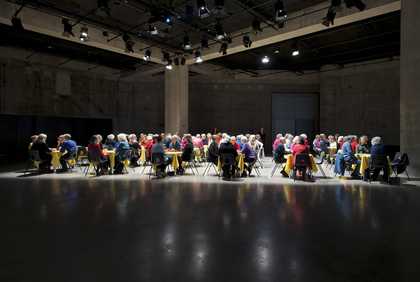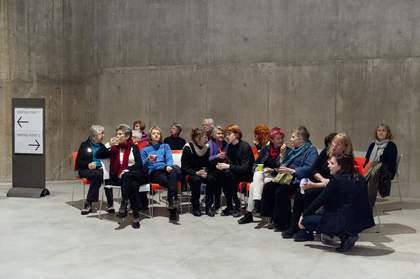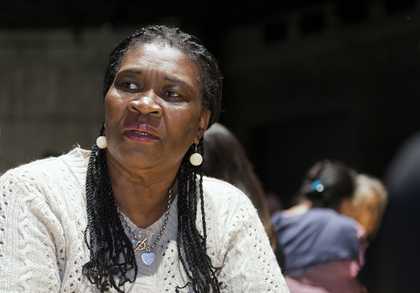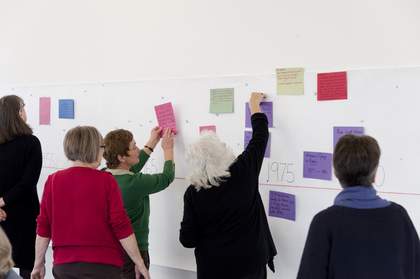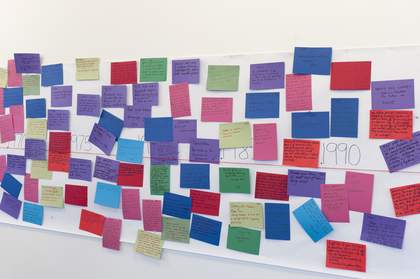On 3 February 2013 American artist Suzanne Lacy invited four hundred women aged over sixty to participate in the live performance event Silver Action in the Tanks at Tate Modern. The six-hour event was a continuation of Lacy’s work involving older women, a demographic she had also worked with during the making of Crystal Quilt 1985–7, which had been displayed at Tate Modern for the opening of the Tanks. Silver Action used the open space of the Tanks to create a series of encounters and conversations between UK-based women who had been involved in activism and protest from the 1950s to the 1980s. Before the live event Lacy invited smaller groups of women to participate in workshops at Tate, which posed questions about their involvement in politics, social justice groups, and other activist movements. The women also compiled a collective timeline of significant events from their lives in which they engaged with activism in either a public or a private realm. These were then compared to the broader timeline Lacy, and others involved in the project, had created of the strikes, protests, and changes in legislation, which had impacted on women’s lives in Britain since the late 1950s. The conversations at the workshop became the basis for some of the discussions during the live event, where a similar timeline was created and displayed. Although the public were invited into the Tanks for the live event, their numbers were limited and they were present as witnesses rather than participants. Some younger women, however, had also been invited to attend with the sole purpose of live blogging and tweeting the conversations they experienced, both documenting the women’s participation, and expanding the conversations onto an online platform.
During the live performance of Silver Action Lacy created a number of different spaces within which the women could interact and begin conversations. One space was particularly reminiscent of Crystal Quilt, using collapsible square card tables, covered with yellow table cloths, to allow groups of four women to have open conversations about their personal experiences within women’s activism.1 The women could move in and out of this space, with groups of fifty to a hundred women occupying the space at any time, being replaced every hour, meaning that 400 women were able to participate overall. At points during the conversations, stewards to the event would invite individual women to have their stories transcribed. The women would relay their stories to one of five typists, who would transcribe these and have them projected onto the walls of the Tank as they spoke. A second space set up by Lacy to facilitate conversation was the ‘kitchen table’. Here small groups of women who had been involved in significant groups or movements were asked to discuss, for an hour, their personal involvement in protest and activism, as well as broader issues around the position of women in society. As well as being a larger group, this conversation-space differed from the smaller square tables as it was intended primarily to be documented through film. The space was brightly lit, with three cameras positioned at different angles in order to capture the conversations in full. The final space created by Lacy was designated for ‘meeting groups’. In this case Lacy invited existing women’s groups to participate by holding one of their meetings in the Tanks, allowing the audience to witness activism in action in the form of an activist group meeting. These conversations were not shaped by Lacy’s particular artistic interests, or the discussions from the workshop, but by the practicalities of what each group was trying to achieve.
Although Lacy invited women over the age of sixty to participate in Silver Action, her intention was not to focus solely on age or ageing within the work but rather to think about the history of women’s engagement in the social, political, and public realms as activists and catalysts for change, as well as the particular challenges faced in these areas by older women. While Lacy invited women who had been involved in significant historical moments, such as the Ford sewing machinists’ strike of 1968, and women who had been involved with the women’s peace camps at Greenham Common, she was also interested in conversations about the personal, posing questions about what had encouraged the individual women to become involved in activism, and exploring the implications of family, social expectations, the law, and other institutions on women’s lives. In the invitations to the numerous participants, Lacy and her collaborators were keen to emphasise that the core audience for the live event was the women themselves. As an ‘unscripted performance of staged conversations’, in the words of the introductory wall text – the event was more about creating a space, or spaces, within which these conversations could happen and be shared amongst the group. The public, in their limited numbers, were incidental to the activities taking place before them, witnesses to the conversations, which continued even without a public audience to spectate. In bringing these conversations into the space of the Tanks, Lacy was both facilitating them and also making public conversations that had already been happening, over a number of decades, beyond the public view. Regardless of the content of the individual conversations between the small groups of women, the meeting groups, or the ‘kitchen table’ groups, in the collectivisation of the act of conversation, Lacy had sought to capture visually, and through the specific content discussed, the impact of older women in the United Kingdom on political and social discourse, movements, and activism.
Acatia Finbow
June 2016


